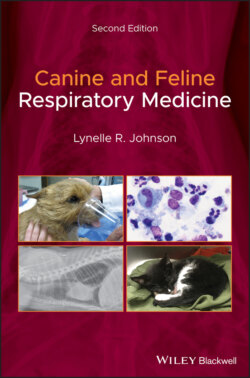Читать книгу Canine and Feline Respiratory Medicine - Lynelle Johnson R., Lynelle R. Johnson - Страница 23
Physical Examination
ОглавлениеCervical and thoracic auscultation, as described for evaluation of animals with cough, is important for animals that present with tachypnea, because many diseases will result in both cough and tachypnea. In addition to listening for increased sounds, it is important to determine if there is an absence of lung sounds, which might indicate the presence of fluid or air in the pleural space.
A notable clinical sign associated with parenchymal or pleural disease is a rapid, shallow breathing pattern, although with pleural disease, exaggerated chest wall motion or hyperpnea can sometimes be present in conjunction with a rapid respiratory rate. In animals with severe respiratory distress, elbows are abducted and the neck is extended to facilitate movement of air into the alveoli. Parenchymal diseases are characterized by increased lung sounds or detection of adventitious sounds. When pleural effusion is present, lung sounds are ausculted in the dorsal fields only and muffled sounds are heard ventrally; heart sounds are also muffled. Pneumothorax leads to an absence of lung sounds dorsally due to compression by air, and lung sounds are present in the ventral fields only. In some cases, a line of demarcation can be ausculted between normal and abnormal lung sounds, indicating a fluid line or the boundaries of air accumulation.
Figure 1.5 Each region of the thorax should be percussed to detect regional differences in the air/soft tissue sounds that are created. One hand is placed against the thorax and is rapped quickly and sharply with the curved fingers of the alternate hand.
In addition to auscultation, thoracic percussion aids in determining if pleural disease is present. Percussion can be performed using a pleximeter and mallet or by placing the fingers of one hand on the chest and rapidly striking them with fingers of the opposite hand (Figure 1.5). The sound that develops will vary depending on whether an air or fluid density is present within the thoracic cavity. Percussion of the chest in a region filled with fluid reveals a dull sound, while in an animal with pneumothorax or air trapping, percussion results in increased resonance. This technique is somewhat limited in a cat or small dog because of the small size of the thoracic cavity.
